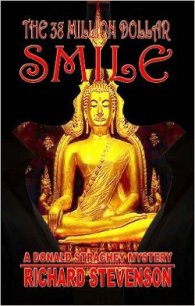Congo - Crichton Michael (читать книги полностью без сокращений бесплатно TXT) 📗
HUSTN STAIN OVRIDE CLR BANX.
This was an emergency signal; she had never seen it before on a field expedition. She cleared the memory banks and pushed the transmit button. There was a burst transmission delay, then the screen printed:
COMPUTR DESIGNATN MAJR ERUPIN SIGNATR MU-KENKO ADVIS LEAV SITE NOW EXPEDN JEPRDY DANGR REPET ALL LEAV SITE NOW.
Ross glanced across the campsite. Kahega was making breakfast; Amy squatted by the fire, eating a roasted banana (she had got Kahega to make special treats for her); Munro and Elliot were having coffee. Except for the black ashfall, it was a perfectly normal morning at the camp. She looked back at the screen.
MAJR ERUPTN SIGNATR MUKENKO ADVIS LEAV SITE NOW.
Ross glanced up at the smoking cone of Mukenko. The hell with it, she thought. She wanted the diamonds, and she had gone too far to quit now.
The screen blinked: PLS SIGNL REPLY.
Ross turned the transmitter off.
As the morning progressed they felt several sharp jolting earth tremors, which released clouds of dust from the crumbling buildings. The rumblings of Mukenko became more frequent. Ross paid no attention. “It just means this is elephant country,” she said. That was an old geological adage: “If you’re looking for elephants, go to elephant country.” Elephant country meant a likely spot to find whatever minerals you were looking for. “And if you want diamonds,” Ross said, shrugging, “you go to volcanoes.”
The association of diamonds with volcanoes had been recognized for more than a century, but it was still poorly understood. Most theories postulated that diamonds, crystals of pure carbon, were formed in the intense heat and pressure of the upper mantle one thousand miles beneath the earth’s surface. The diamonds remained inaccessible at this depth except in volcanic areas where rivers of molten magma carried them to the surface.
But this did not mean that you went to erupting volcanoes to catch diamonds being spewed out, Most diamond mines were at the site of extinct volcanoes, in fossilized cones called kimberlite pipes, named for the geological formations in Kimberley, South Africa. Virunga, near the geologically unstable Rift Valley, showed evidence of continuous volcanic activity for more than fifty million years. They were now looking for the same fossil volcanoes which the earlier inhabitants of Zinj had found.
Shortly before noon they found them, halfway up the hills east of the city-a series of excavated tunnels running into the mountain slopes of Mukenko.
Elliot felt disappointed. “I don’t know what I was expecting,” he said later, “but it was just a brown-colored tunnel in the earth, with occasional bits of dull brown rock sticking out. I couldn’t understand why Ross got so excited.” Those bits of dull brown rock were diamonds; when cleaned, they had the transparency of dirty glass.
“They thought I was crazy,” Ross said, “because I began jumping up and down. But they didn’t know what they were looking at.”
In an ordinary kimberilte pipe, diamonds were distributed sparsely in the rock matrix. The average mine recovered only thirty-two karats-a fifth of an ounce-for every hundred tons of rock removed. When you looked down a diamond mine-shaft, you saw no diamonds at all. But the Zinj mines were lumpy with protruding stones. Using his machete, Munro dug out six hundred karats. And Ross saw six or seven stones protruding from the wall, each as large as the one Munro had removed. “Just looking,” she said later, “I could see easily four or five thousand karats. With no further digging, no separation, nothing. Just sitting there. It was a richer mine than the Premier in South Africa. It was unbelievable.”
Elliot asked the question that had already formed in Ross’s own mind. “If this mine is so damn rich,” he said, “why was it abandoned?”
“The gorillas got out of control,” Munro said. “They staged a coup.” He was laughing, plucking diamonds out of the rock.
Ross had considered that, as she had considered Elliot’s earlier suggestion that the city had been wiped out by disease. She thought a less exotic explanation was likely. “I think,” she said, “that as far as they were concerned, the diamond mines had dried up.” Because as gemstones, these crystals were very poor indeed-blue, streaked with impurities.
The people of Zinj could not have imagined that five hundred years in the future these same worthless stones would be more scarce and desirable than any other mineral resources on the planet.
“What makes these blue diamonds so valuable?”
“They are going to change the world,” Ross said, in a soft voice. “They are going to end the nuclear age.”
2. War at the Speed of Light
IN JANUARY, 1979, TESTIFYING BEFORE THE Senate Armed Services Subcommittee, General Franklin F. Martin of the Pentagon Advanced Research Project Agency said, “In 1939, at the start of World War II, the most important country in the world to the American military effort was the Belgian Congo.” Martin explained that as a kind of “accident of geography” the Congo, now Zaire, has for forty years remained vital to American interests-and will assume even more importance in the future. (Martin said bluntly that “this country will go to war over Zaire before we go to war over any Arab oil state.”)
During World War II, in three highly secret shipments, the Congo supplied the United States with uranium used to build the atomic bombs exploded over Japan. By 1960 the U.S. no longer needed uranium, but copper and cobalt were strategically important. In the 1970s the emphasis shifted to Zaire’s reserves of tantalum, wolframite, germanium- substances vital to semi conducting electronics. And in the 1980s, “so-called Type IIb blue diamonds will constitute the most important military resource in the world”-and the presumption was that Zaire had such diamonds. In General Martin’s view, blue diamonds were essential because “we are entering a time when the brute destructive power of a weapon will be less important than its speed and intelligence.”
For thirty years, military thinkers had been awed by intercontinental ballistic missiles. But Martin said that “ICBMs are crude weapons. They do not begin to approach the theoretical limits imposed by physical laws. According to Einsteinian physics, nothing can happen faster than the speed of light, 186,000 miles a second. We are now developing high-energy pulsed lasers and particle beam weapons systems which operate at the speed of light. In the face of such weapons, ballistic missiles traveling a mere 17,000 miles an hour are slow-moving dinosaurs from a previous era, as inappropriate as cavalry in World War I, and as easily eliminated.”
Speed-of-light weapons were best suited to space, and would first appear in satellites. Martin noted that the Russians had made a “kill” of the American spy satellite VV/ 02 as early as 1973; in 1975, Hughes Aircraft developed a rapid aiming and firing system which locked onto multiple targets, firing eight high-energy pulses in less than one second. By 1978, the Hughes team had reduced response time to fifty nanoseconds-fifty billionths of a second-and increased beam accuracy to five hundred missile knockdowns in less than one minute. Such developments presaged the end of the ICBM as a weapon.
“Without the gigantic missiles, miniature, high-speed computers will be vastly more important in future conflicts than nuclear bombs, and their speed of computation will be the single most important factor determining the outcome of World War III. Computer speed now stands at the center of the armament race, as megaton power once held the center twenty years ago.
“We will shift from electronic circuit computers to light circuit computers simply because of speed-the Fabry-Perot Interferometer, the optical equivalent of a transistor, can respond in 1 picosecond (10 12 seconds), at least 1,000 times faster than the fastest Josephson junctions.” The new generation of optical computers, Martin said, would be dependent on the availability of Type IIb boron-coated diamonds.


![[Magazine 1968-012] - The Million Monsters Affair - Davis Robert Hart (читать книги TXT) 📗](/uploads/posts/books/56864/56864.jpg)

